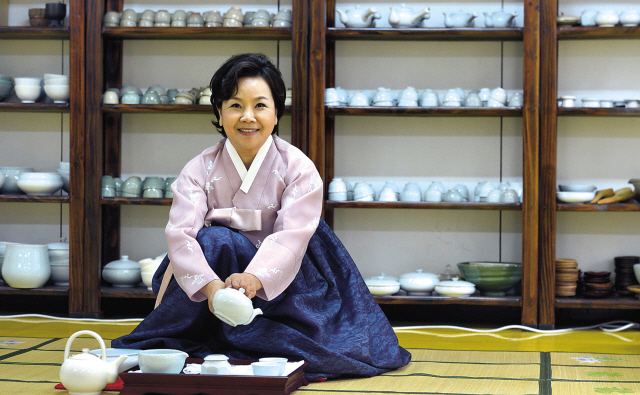Good cup of green tea bestowed by nature
Korean tea ceremony values balance of colors and taste with touch of style and grace
By Lee Woo-youngPublished : June 14, 2013 - 20:07
Korean green tea has been traditionally well known for its taste and quality thanks to the clean water found in Korean nature, according to Park Kwang-ok, director of the eastern Seoul office of the Korea Tea Culture Association.
“The quality of water and temperature affect the taste of tea. Korea is known for the clean water, one of the important factors for making a good-quality tea,” said Park in an interview with The Korea Herald.
“The high quality of tea has affected the tea ceremony of Korea,” said Park.
Because of the high quality of the tea, he said, Koreans didn’t have to focus on performances such as exaggerated hand gestures, but rather on the sincere act of brewing good-quality tea for their guests.
Korea, China and Japan share a long history of tea culture, which has been at the base of the rich civilizations developed in East Asia.
However, the tea ceremonies of the neighboring countries vary in style. In China, the tea ceremony is conducted to emphasize the aroma of the tea; in Japan, the color of the tea; and in Korea, the taste and style and grace.
“The quality of water and temperature affect the taste of tea. Korea is known for the clean water, one of the important factors for making a good-quality tea,” said Park in an interview with The Korea Herald.
“The high quality of tea has affected the tea ceremony of Korea,” said Park.
Because of the high quality of the tea, he said, Koreans didn’t have to focus on performances such as exaggerated hand gestures, but rather on the sincere act of brewing good-quality tea for their guests.
Korea, China and Japan share a long history of tea culture, which has been at the base of the rich civilizations developed in East Asia.
However, the tea ceremonies of the neighboring countries vary in style. In China, the tea ceremony is conducted to emphasize the aroma of the tea; in Japan, the color of the tea; and in Korea, the taste and style and grace.

“The Chinese tea ceremony features performances such as pouring water from high up in the air to the table to stimulate tea leaves brewing in the water,” Park said. “The Japanese tea ceremony features stricter guidelines as the culture was developed by the warrior elites.”
“In Korea, offering tea shows the manners and style of one’s family. When guests are invited, the female host of the house serves tea and some sweets with her daughter. Through the tea-serving process, guests would get an idea of their family’s tradition and customs,” said Park.
“Yet, it was more about serving guests and building friendships, than showing off.”
A unique tea culture of Korea called “gyubang darye” (tea ceremony) was developed inside the living room where Korean women of the Joseon period spent most of their time making various household crafts and receiving guests.
Because of Confucian values that supported patriarchal Joseon society, women were not allowed to go outside freely, but had to stay inside. The gyubang tea ceremony is part of the culture developed among women of high class.
The Korea Tea Culture Association preserves the tradition of gyubang tea ceremony as its chairman Lee Gui-rye holds the title as Korea’s intangible cultural property for the gyubang tea ceremony.
However, as the Japanese tea ceremony started to prevail in Korea during the colonial period, the Korean tea ceremony has been little acknowledged by the Korean public.
“A Korean man asked me whether we have our own tea ceremony when I was performing the traditional gyubang tea ceremony along with other tea masters from Japan and China. I was shocked when he said that,” said Park.
In the Korean tea ceremony, guests drink the first cup of tea without dessert to fully appreciate the taste and aroma. In the second round, guests are offered traditional sweets made of sesame, chestnut, honey and more.
“The desserts that are served with tea should not be too sweet, or too big that they hinder the experience of drinking tea,” said Park. “Fruits are not served either.”
Guests get the honor of having the last drop of tea, considered to have the best taste.
“The last drop of the tea bowl has the best taste. It’s a precious drop that Korean ancestors called ‘the drop of jade,’” said Park.
By Lee Woo-young (wylee@heraldcorp.com)



![[Exclusive] Korean military set to ban iPhones over 'security' concerns](http://res.heraldm.com/phpwas/restmb_idxmake.php?idx=644&simg=/content/image/2024/04/23/20240423050599_0.jpg&u=20240423183955)



![[Herald Interview] 'Amid aging population, Korea to invite more young professionals from overseas'](http://res.heraldm.com/phpwas/restmb_idxmake.php?idx=644&simg=/content/image/2024/04/24/20240424050844_0.jpg&u=20240424200058)


![[Pressure points] Leggings in public: Fashion statement or social faux pas?](http://res.heraldm.com/phpwas/restmb_idxmake.php?idx=644&simg=/content/image/2024/04/23/20240423050669_0.jpg&u=)








